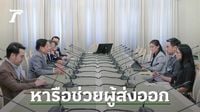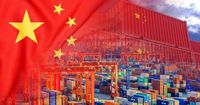On April 16, 2025, the National Bureau of Statistics (NBS) of China reported a significant increase in the country’s exports for March, rising by 12.4% year-on-year. This surge marks the strongest growth since October 2024, as Chinese businesses ramped up their export activities to avoid facing additional tariffs imposed by the United States. However, imports during the same month fell by 4.3% year-on-year, reflecting ongoing weak domestic demand.
According to the NBS report published on April 14, China’s trade surplus for March stood at $102.64 billion, slightly down from $104.8 billion in December 2024. The data showed that exports to the United States increased by 9.1%, while imports from the U.S. decreased by 9.5%, indicating a complex trade relationship as the U.S. remains China’s largest trading partner, accounting for approximately 10% of China’s overall trade.
Exports to ASEAN countries also saw a notable rise, increasing by 11.6% in March, with exports to Vietnam alone surging nearly 19%. Meanwhile, imports from ASEAN rose by 9.8%. In addition, exports to the European Union (EU) grew by 10.3%, while imports from the EU decreased by 7.5%. This trend underscores China's diverse trading relationships as it navigates the complexities of global trade.
In a separate development, Phichai Chunhawachira, Thailand's Deputy Prime Minister and Minister of Finance, met with Sethaput Suthiwartnarueput, Governor of the Bank of Thailand, to discuss measures aimed at supporting Thai exporters facing challenges from U.S. tariffs. The meeting took place on April 16, 2025, and lasted approximately one hour.
Phichai revealed that the discussion focused on strategies to manage the impact of increased U.S. tariffs on Thai exports, particularly as the U.S. has extended the enforcement of these tariffs by an additional 90 days. He emphasized the need to assess the situation carefully and gather more information before implementing any specific measures to support exporters.
"We need to closely monitor the situation and consider the potential impacts on our trade with the U.S. and other countries affected by these tariffs," Phichai stated. He acknowledged that the recent U.S. tariff policies have created uncertainty in the market, affecting both the Thai economy and its trading relationships.
Despite the challenges, Phichai reassured that the current liquidity in Thailand's financial system is sufficient to handle market volatility. He mentioned that the upcoming Monetary Policy Committee (MPC) meeting on April 30 will consider various factors, including inflation and currency stability, to determine the appropriate interest rate policy.
Moreover, the discussions also touched upon the introduction of virtual banks in Thailand, with the Bank of Thailand proposing names of qualified applicants for licenses to operate these banks. This initiative is expected to enhance financial services and attract foreign investment.
Phichai emphasized that while the focus of the meeting was on managing export challenges, the broader economic landscape must also be considered. "The impact of U.S. tariffs is not just a bilateral issue; it affects our trade relations with other nations as well," he noted. He called for a collaborative approach to address the diverse challenges faced by different sectors of the economy, including small and large businesses.
As Thailand navigates this complex trade environment, the government is committed to supporting its exporters while maintaining financial stability. The ongoing discussions with the Bank of Thailand highlight the proactive measures being taken to adapt to changing global trade dynamics.
In summary, China's export growth reflects its ongoing efforts to mitigate the effects of U.S. tariffs, while Thailand is actively seeking solutions to support its exporters facing similar challenges. Both nations are adapting to a rapidly changing global trade landscape, with a focus on collaboration and strategic planning.





